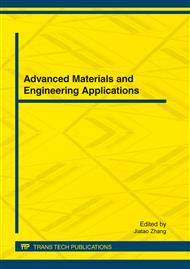[1]
Chen Y, Bagnall D M, Koh H J, et al. Plasma assisted molecular beam epitaxy of ZnO on c-plane sapphire: growth and characterization, J. Appl. Phys. 84(1998) 3912-3918.
DOI: 10.1063/1.368595
Google Scholar
[2]
Fan Z, Lu J G. Zinc oxide nanostructures: Synthesis and properties, J. Nanosci. Nanotechnol. 5(2005)1561-1573.
Google Scholar
[3]
Rao C N R, Gundiah G,Deepak F L, et al. Carbon-assisted synthesis of inorganic nanowires, J. Mater. Chem. 14(2004)440-450.
DOI: 10.1039/b310387k
Google Scholar
[4]
Huang M H,Mao S,Feick H,et al. Room-temperature ultraviolet nanowire nanolasers, Science. 292(2001)1897-1899.
DOI: 10.1126/science.1060367
Google Scholar
[5]
Liu C Y,Zhang B P,Lu Z W,et al. Fabrication and characterization of ZnO film based UV photodetector, J. Mater. Sci. : Mater. Electron. 20(2009)197- 201.
DOI: 10.1007/s10854-008-9698-x
Google Scholar
[6]
Qin Y, Wang X D, Wang Z L. Microfibre-nanowire hybrid structure for energy scavenging, Nature. 451(2008)809-813.
DOI: 10.1038/nature06601
Google Scholar
[7]
Song J H, Wang X D, Liu J, et al. Piezoelectric Potential Output from ZnO Nanowire Functionalized with p-Type Oligomer, Nano Lett. 8(2008)203-207.
DOI: 10.1021/nl072440v
Google Scholar
[8]
Zhao Su Ling, Kan Peng Zhi, Xu Zheng, et al. Electroluminescence of ZnO nanorods/MEH-PPV heterostructure devices, Organic Electronics . 11(2010)789-793.
DOI: 10.1016/j.orgel.2010.01.020
Google Scholar
[9]
Michael Breedon, Mohammad Bagher Rahmani, Sayyed-Hossein Keshmiri, et al. Aqueous synthesis of interconnected ZnO nanowires using spray pyrolysis deposited seed layers, Materials Letters . 64(2010)291-294.
DOI: 10.1016/j.matlet.2009.10.065
Google Scholar
[10]
S. Sepulveda-Guzman,B. Reeja-Jayan,E. De la Rosa, et al. Room-temperature deposition of crystalline patterned ZnO films by confined dewetting lithography, Applied Surface Science. 256(2010)3386-3389.
DOI: 10.1016/j.apsusc.2009.12.039
Google Scholar
[11]
H. -G. Chen, Sheng-Rui Jiana, Zheng-Wei Li, et al. Epitaxial growth of self-arranged periodic ZnO nanostructures on sapphire substrates grown by MOCVD, J. Alloys Compd. 10(2010)1016.
DOI: 10.1016/j.jallcom.2010.02.195
Google Scholar
[12]
Y.J. Chen, Y.Y. Shih, C.H. Ho, et al. Effect of temperature on lateral growth of ZnO grains grown by MOCVD, Ceramics International. 36(2010)69–73.
DOI: 10.1016/j.ceramint.2009.06.018
Google Scholar
[13]
Y.W. Heo, D.P. Norton, L.C. Tien, et al. ZnO nanowire growth and devices, Mater. Sci. Eng. 47(2004)1-47.
Google Scholar
[14]
M. Huang, Y. Wu, H. Feick, et al. Catalytic Growth of Zinc Oxide Nanowires by Vapor Transport, Advanced Materials. 13(2001)113-116.
DOI: 10.1002/1521-4095(200101)13:2<113::aid-adma113>3.0.co;2-h
Google Scholar
[15]
A. Kolodziejczak-Radzimska, T. Jesionowski, A. Krysztafkiewicz. Obtaining zinc oxide from aqueous solutions of KOH and Zn(CH3COO)2, Physicochemical Problems of Mineral Processing. 44(2010)93-102.
Google Scholar
[16]
Zhang Can-yun. High-quality oriented ZnO films grown by sol–gel process assisted with ZnO seed layer, Journal of Physics and Chemistry of Solids. 71(2010)364-369.
DOI: 10.1016/j.jpcs.2010.01.001
Google Scholar
[17]
Zhaoyi Zhou, Yaping Zhao, Zaisheng Cai. Low-temperature growth of ZnO nanorods on PET fabrics with two-step hydrothermal method, Applied Surface Science. 256(2010)4724-4728.
DOI: 10.1016/j.apsusc.2010.02.081
Google Scholar
[18]
A. Aimable, M.T. Buscaglia, V. Buscaglia, et al. Polymer-assisted precipitation of ZnO nanoparticles with narrow particle size distribution, Journal of the European Ceramic Society. 30(2010)591–598.
DOI: 10.1016/j.jeurceramsoc.2009.06.010
Google Scholar
[19]
Li W J, Shi E W, Zhong W Z, et al. Growth mechanism and growth habits of oxide crystal, Journal of Crystal Growth. 203(1999)186.
DOI: 10.1016/s0022-0248(99)00076-7
Google Scholar
[20]
Zhang J,Sun L D,Yin J L,et al. Control of ZnO morphology via a simple solution route, Chem. Mater. 14(2002) 4172- 4177.
DOI: 10.1021/cm020077h
Google Scholar
[21]
Genban Sun, Minhua Cao, Yonghui Wang, Changwen Hu, Yichun Liu, Ling Ren , Zhifa Pu. Anionic surfactant-assisted hydrothermal synthesis of high-aspect-ratio ZnO nanowires and their photoluminescence property, Materials Letters. 60 (2006).
DOI: 10.1016/j.matlet.2006.01.088
Google Scholar
[22]
G.H. Schoenmakers, D. Vanmaekelbergh, J.J. Kelly, Study of Charge Carrier Dynamics at Illuminated ZnO Photoanodes, J. Phys. Chem. 100(1996) 3215.
DOI: 10.1021/jp952392f
Google Scholar


